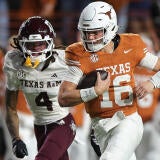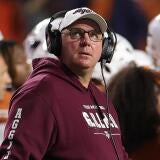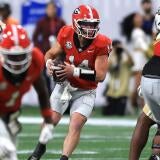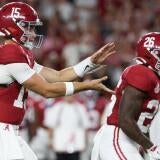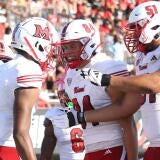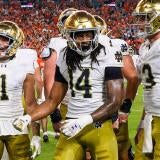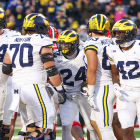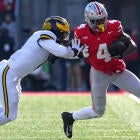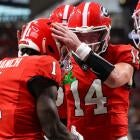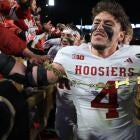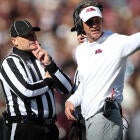Meet Ramogi Huma, whose decades-long crusade for fairness in college athletics is finally coming to fruition
If you don't know his name, you certainly know what he has wrought

It was a team meeting you'd never want to be a part of. Ramogi Huma was a wide-eyed prospect from Covina, California, in the mid-1990s absorbing the ground rules for playing at UCLA.
"They called them voluntary workouts, but they clearly weren't voluntary," said Huma, a linebacker who went on to grab all of two career interceptions. "When we were told that the NCAA had a rule that, should we be injured during summer workouts, UCLA was prohibited from paying for our medical expenses, that was a big deal for me."
So big that something clicked. Something bigger than himself and, ultimately, bigger than the NCAA and college athletics.
A players' rights movement was born. A quarter of a century later, Huma is college athletics' chief activist. The title, well, we just gave him that because the folks he antagonizes certainly won't.
If you don't know his name, you certainly know what he has wrought. As college athletics stands on the precipice of transformative change to something that may not even resemble college athletics, Huma is the college landscape's leading disruptor, a force so subtly impactful that he has earned that one-name reference that everybody knows in the college halls of power: "Ramogi."
When you put the resume of Huma -- executive director of the National College Players Association -- up against any of college athletics' power brokers, no one has done more to further college players' rights.
If nothing else, he has outlasted most of them. In reality, Huma has arguably accomplished more than any of them. During the 23 years since Huma formed the nonprofit NCPA in 2001, the NCAA has had four executive directors/presidents. The Power Five conferences employed a combined 15 commissioners.
Huma, 46, remains as a singular force, pushing for what amounts to basic human rights through 12 sessions of Congress and four presidents. Yes, he has been that impactful, speaking truth to power in the highest seats of power but also making sense.
"He's as totally committed to trying to make the lives of athletes better on the ground," said Ellen Staurowsky, an Ithaca College professor who has partnered with Huma on several research projects. "[He's] going against the system even with all these lawsuits, even with all these losses in court and these massive amounts of money college executives have paid to defend a stance that is indefensible, Ramogi has tried to hold that to account."
These times scream for Huma's wisdom. College athletics are almost sure to change forever with a proposed settlement of the House v. NCAA lawsuit, possible by the end of the month. The plaintiffs, a class action of former athletes from 2017 to the present, are led by powerful anti-trust attorney Jeffrey Kessler. They are in talks with the Power Four conferences and NCAA who must bend in some form in the multi-billion dollar suit or risk the current state of existence.
With college sports on the brink of sharing revenue with athletes, Huma should be the player's representative, this age's version of Marvin Miller, the Major League Baseball players union chief who ushered in the age of free agency.
One compelling voice to lead them all.
Huma isn't interested ... for now.
"I've always had a role advocating," he said. "I don't see that changing. It's not so simple what the future looks like, period."
It won't happen in the near future because the system isn't ready for collective bargaining or a union or, obviously, Huma as its player rep. The settlement talks don't account for it. In fact, those same power brokers are doing everything they can to keep the athletes from becoming employees. This time around.
"There's a way to do this [settlement] where everybody can win," said Jim Cavale, co-founder of players association Athletes.org. "You can bundle in [the settlement] a lot of the other issues into this deal—including the transfer portal, including medical coverage and mental health. How about players agreeing to play up to three more games [actually four] in the College Football Playoff?"
The multiple lawsuits faced by the NCAA reflect these fractious times. States are in direct competition with each other for NIL benefits. College athletes are so transitory -- passing through college sometimes after only one year -- how do you get them together on big union issues?
Huma remains as altruistic as they come. The father of two teenage boys checks in on UCLA sports occasionally. A man who was making $83,000 as recently as 2019 is quietly putting millions in the pockets of athletes. The ongoing fight is for athletes' health, welfare, and as much money as they can get. You know, just like the average budding entrepreneurial student walking across campus.
Part of Huma's legacy came full circle in 2016 when UCLA's starting quarterback echoed his activism. Huma's impact has only grown.
"It was a nerve-racking time," Huma said of the early days. "Even when I went and testified [to Congress in 2002] for the first time I could have felt there was going to be a moment when schools in the NCAA proved us wrong, where our arguments weren't valid. It just never came. We just kept getting more and more support."
Through more than two decades of that activism, Huma has become, if not the most powerful person in college sports, perhaps the most enduring. Certainly the most accomplished given the current climate.
Huma and his grassroots organization have been behind the promotion, advocacy, lobbying, and passage of:
- A $70 million settlement with the NCAA 10 years ago that provided for enhanced concussion detection and diagnosis. It was basically the college version of the NFL's landmark $765 million concussion settlement.
- California's Student-Athletes Bill of Rights in 2012. The NCPA-sponsored bill required schools to pay for college athlete's medical expenses.
- Huma founded the first college athletes' union. The College Athletes Players Association formed in 2014 at Northwestern. The regional National Labor Relations Board ruled players had a right to organize. In 2015, the national office overruled the local office.
- Huma was a consultant in the landmark lawsuits White v. NCAA and O'Bannon v. NCAA, all of which eventually led to the Alston v. NCAA decision in 2021
Huma is still astounded at the 9-0 Supreme Court verdict that opened the gates to the current landscape. That ruling basically stripped the NCAA of any amateur ideal it had left. His life's work had paid off when Justice Brent Kavanaugh went out of his way to criticize the association.
"I know judges read newspapers too," Huma said.
- NIL. The NCPA co-sponsored California's Fair Pay to Play Act that essentially kicked off the name, image, and likeness movement. Dozens of other states copied the law forcing the NCAA to change its rules shortly after the Alston decision.
- College administrators everywhere are holding their breath over California Assembly Bill 252. It would establish a unique revenue-sharing model for state schools that would create a degree completion fund. Athletes would share 50% of athletic revenue minus the value of their scholarship.
Bill sponsor, California assemblyman Chris Holden, has worked closely with the NCPA on passage of the bill that could eventually see some athletes get $100,000 annually. The bill is still in committee.
All of it leads to Huma being essentially the O.G. of players' rights. The likes of Caleb Williams and Caitlin Clark should know who he is. They are figuratively standing on his shoulders. They wouldn't have those monster corporate deals if Huma (and others) hadn't argued in state legislatures, on Capitol Hill, and in the media for athletes' rights.
He's the one who has advocated for safety protections and fair compensation longer than anyone else.
Not a bad result for a guy who initially asked around UCLA for what it took to form a student group on campus. He was told three people and a mission statement. He formed that first advocacy group with former teammate Ryan Roques and Ali Abdul Azziz. Part of Huma's indignation took hold when former teammate Donnie Edwards was penalized by the NCAA for accepting $150 in groceries from an agent.
"I love seeing Caleb Williams and Caitlin Clark and athletes utilizing NIL," Huma said. "That didn't cross my mind that we didn't get that. It's very rewarding. It's also not full economic equity. That's another job on top of their job."
The unsettling urgency can be felt throughout college sports. The NCPA might not be around had it not partnered with the United Steelworkers in 2001. The union still provides funding. That Northwestern decision only hinted at what was to come. Dartmouth basketball players recently unionized. There is a growing feeling that the only solution to any of it is for players to be employees.
"I honestly am flabbergasted," Staurowsky said of the settlement talks. "We come all the way up to employment and then somehow everybody starts to tap out? Honestly, we're going to do that now?

Several sources reacted to a Monday report that players could object to the House settlement on an annual basis. That was a case of semantics. Kessler told CBS Sports there is a typical legal maneuver in such settlements he termed an "objection procedure." That involves a once-a-year "look-in" for the term of the settlement for any of the players objecting.
"Those objections are almost never granted but it's a right," Kessler said. "This is just a way of saying for the life of the settlement, people could file objections if they want to. It's just a procedure when you're going forward for new members of the class they can file an objection if they want."
The question then becomes who would represent the players in such a procedure? Several sources weighed in Monday reinforcing that the players don't have a voice in the settlement itself.
"They're trying to do everything they can to provide a way to reach an agreement that benefits these athletes short of them being employees," said sports law attorney Mit Winter said of the defendants.
The legacy of inattention to players' rights is hard to deny. In a 5 1/2-month span in 2001, three players at Power Five schools collapsed during workouts and later died. The deaths caused at least national concern, if not outrage.
"We were waiting for the NCAA to come down and investigate what was going on," Huma said, "whether these deaths were negligent or not. The NCAA never came. We had to do our research and realize they were never going to come."
What he found was few hard and fast rules regarding player safety. Guidelines aren't rules and rules aren't any good unless they are enforced. And enforcement doesn't work unless there are penalties.
The mess former NCAA executive director Mark Emmert left behind still haunts the NCAA today. In a court filing during a wrongful death lawsuit brought by the family of a Division III player who died at practice because of a head injury, the NCAA famously denied, "it has a legal duty to protect student-athletes."
In 2019, Emmert called NIL "an existential threat." Emmert threatened California schools with expulsion from championship events as those bills passed through the state legislature.
Huma seized upon that stance to file a complaint with the Department of Justice for threatening the state schools with a group boycott.
"There were a lot of hopes that were crushed along the way," Huma said.
In the end, the NCAA and member schools have ignored the advice of their supreme leader. Walter Byers was the NCAA, becoming its first executive director, establishing enforcement and basically becoming a one-man show of force. By the time he wrote his memoir, Byers had softened, coming all the way around to the players' side. He advocated for athletes having "the same access to the free market as the coaches enjoyed."
That was 1997, essentially the same year a wide-eyed Huma started to realize he and his teammates deserved the same thing.


